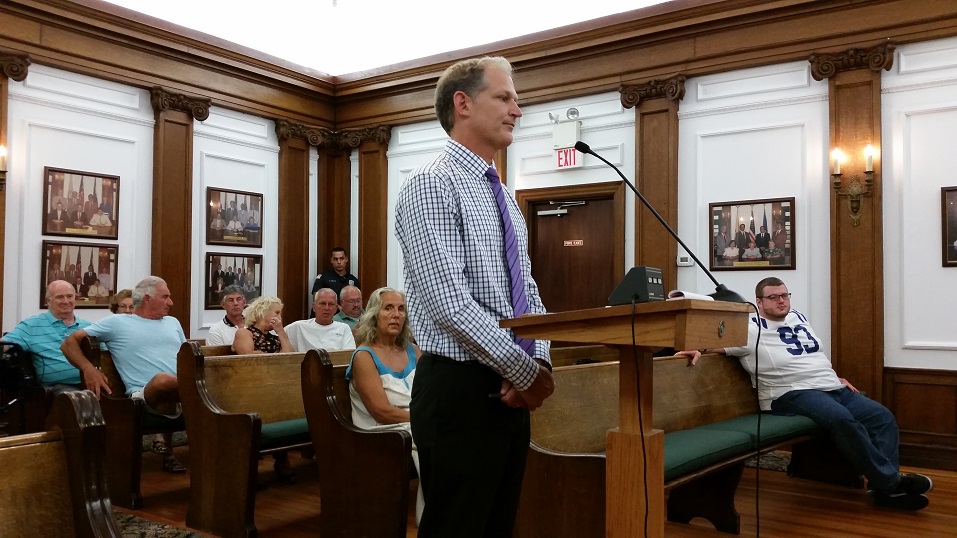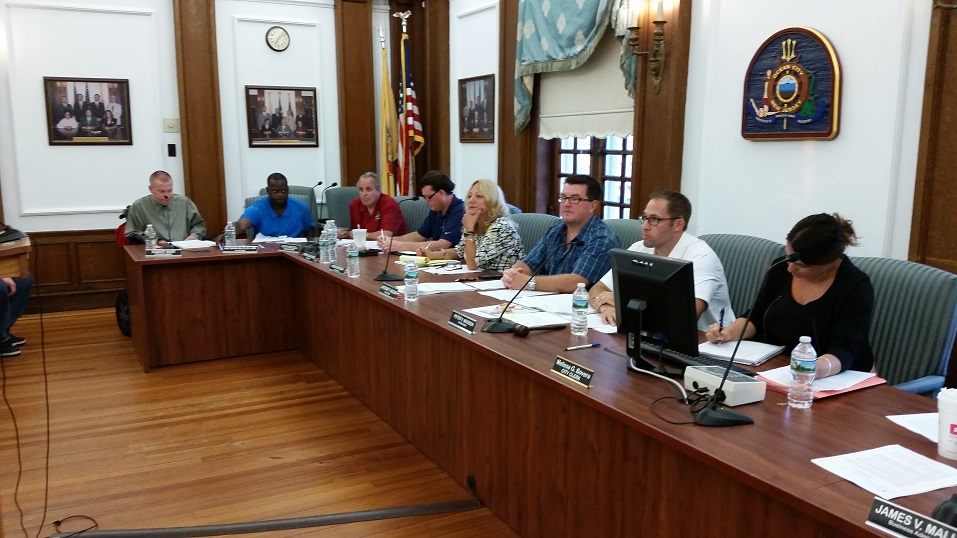Council awarded a $467,500 consulting contract to ACT Engineering Inc. to oversee the city's dredging work this year and design the next round of projects in 2017.
 By Donald Wittkowski
Ocean City is no longer in a pickle over pickleball.
A long-running saga over where to build permanent pickleball courts has finally ended with a compromise agreement.
Michael Allegretto, the city's director of Community Services, said the plan has been endorsed by representatives of both the pickleball and tennis communities.
Allegretto, who had been assigned the task of solving the pickleball dilemma by Mayor Jay Gillian, told City Council at its meeting Thursday night that both sides "seem in agreement."
The plan calls for converting three existing artificial-turf tennis courts at 18th Street and Haven Avenue, next to the Ocean City Intermediate School, into 12 pickleball courts that will have an asphalt playing surface.
This will give pickleball players their first permanent location, ending several years of controversy over where to build enough courts for the fast-growing sport.
"I don't think there is any legitimate reason not to move forward with the plan Mr. Allegretto has proposed," Ocean City pickleball advocate Don Hepner told Council.
Pickleball is played with paddles and a small ball over a net. It combines elements of tennis, ping-pong and badminton.
Ocean City's tennis players had feared they would lose some of their turf courts to accommodate pickleball, but the proposed compromise has something for them, too.
Allegretto said the total number of artificial-turf tennis courts in town will increase from 11 to 12.
Although three of the turf tennis courts at 18th Street and Haven Avenue will be reconfigured for pickleball, three other turf courts there will remain exclusively for tennis.
In addition, four existing asphalt tennis courts at 34th Street will be converted into an artificial-turf playing surface.
The final part of the plan calls for leaving five existing turf courts at Sixth Street for tennis. Five existing asphalt courts at Sixth Street will also remain for tennis, Allegretto said.
Artificial turf, a carpet-like surface, is favored by some tennis players, particularly older ones, because it puts less stress on knees and other joints than asphalt courts.
Terry McKenna, a representative of Ocean City's tennis community, had called for the formation of a committee of tennis and pickleball representatives to study Allegretto's proposal.
McKenna said during the Aug. 25 Council meeting that he believed pickleball and turf tennis players "can co-exist in town."
Last December, the city abandoned plans to convert a public parking lot at Shelter Road and Tennessee Avenue into new pickleball courts. At that time, the mayor directed Allegretto to study possible new locations for pickleball in hopes of "finally putting it all to rest."
By Donald Wittkowski
Ocean City is no longer in a pickle over pickleball.
A long-running saga over where to build permanent pickleball courts has finally ended with a compromise agreement.
Michael Allegretto, the city's director of Community Services, said the plan has been endorsed by representatives of both the pickleball and tennis communities.
Allegretto, who had been assigned the task of solving the pickleball dilemma by Mayor Jay Gillian, told City Council at its meeting Thursday night that both sides "seem in agreement."
The plan calls for converting three existing artificial-turf tennis courts at 18th Street and Haven Avenue, next to the Ocean City Intermediate School, into 12 pickleball courts that will have an asphalt playing surface.
This will give pickleball players their first permanent location, ending several years of controversy over where to build enough courts for the fast-growing sport.
"I don't think there is any legitimate reason not to move forward with the plan Mr. Allegretto has proposed," Ocean City pickleball advocate Don Hepner told Council.
Pickleball is played with paddles and a small ball over a net. It combines elements of tennis, ping-pong and badminton.
Ocean City's tennis players had feared they would lose some of their turf courts to accommodate pickleball, but the proposed compromise has something for them, too.
Allegretto said the total number of artificial-turf tennis courts in town will increase from 11 to 12.
Although three of the turf tennis courts at 18th Street and Haven Avenue will be reconfigured for pickleball, three other turf courts there will remain exclusively for tennis.
In addition, four existing asphalt tennis courts at 34th Street will be converted into an artificial-turf playing surface.
The final part of the plan calls for leaving five existing turf courts at Sixth Street for tennis. Five existing asphalt courts at Sixth Street will also remain for tennis, Allegretto said.
Artificial turf, a carpet-like surface, is favored by some tennis players, particularly older ones, because it puts less stress on knees and other joints than asphalt courts.
Terry McKenna, a representative of Ocean City's tennis community, had called for the formation of a committee of tennis and pickleball representatives to study Allegretto's proposal.
McKenna said during the Aug. 25 Council meeting that he believed pickleball and turf tennis players "can co-exist in town."
Last December, the city abandoned plans to convert a public parking lot at Shelter Road and Tennessee Avenue into new pickleball courts. At that time, the mayor directed Allegretto to study possible new locations for pickleball in hopes of "finally putting it all to rest."
 Council awarded a $467,500 consulting contract to ACT Engineering Inc. to oversee the city's dredging work this year and design the next round of projects in 2017.
Allegretto noted that Council still must approve the funding to build the new pickleball courts. The cost is not yet known because the project still must be designed, he said.
Pickleball will not be free at 18th Street. The city will come up with fees for using the new courts. Allegretto said the city will likely have a season pass for pickleball, but still must decide how much to charge.
There are some concerns, however, that the new pickleball courts will create excessive noise and add to parking problems at the 18th Street location.
Gillian said the city may consider planting trees around the courts as a way to muffle the noise.
The city intends to talk to the Board of Education about the possibility of using a school-owned athletic field at 18th Street for parking, Gillian and Allegretto said.
"We're going to sit down with the school and ask nicely," Allegretto said.
In other business Thursday, Council awarded a $467,500 consulting contract to ACT Engineering Inc., of Robbinsville, N.J., to oversee the dredging of the city's sediment-clogged lagoons and channels.
ACT Engineering will supervise the dredging work this year and design the next round of projects for 2017.
The company will also oversee the completion of a temporary road to a disposal site, near the 34th Street Bridge, where dredge spoils are stored before they are hauled away by truck to a Wildwood landfill.
Overall, the mayor has proposed spending $20 million in the next three years to dredge the lagoons and channels along the back bays.
Residents living along the bayfront have repeatedly complained that the lagoons are so shallow that their boats scrape bottom or are trapped at the docks.
For this year, the city plans to dredge the Snug Harbor, Glen Cove and South Harbor areas. Dredging projects for 2017 have not yet been selected.
Work on Snug Harbor, between Eighth and Ninth streets along Bay Avenue, has begun and is expected to be finished by next Wednesday, City Business Administrator Jim Mallon said.
Glen Cove, between 10th and 11th streets along Bay Avenue, is next in line. Mallon said dredging is scheduled to start at Glen Cove next week.
South Harbor, a bayfront area between Tennessee Avenue and Spruce Road, is expected to be dredged later in the year.
Council awarded a $467,500 consulting contract to ACT Engineering Inc. to oversee the city's dredging work this year and design the next round of projects in 2017.
Allegretto noted that Council still must approve the funding to build the new pickleball courts. The cost is not yet known because the project still must be designed, he said.
Pickleball will not be free at 18th Street. The city will come up with fees for using the new courts. Allegretto said the city will likely have a season pass for pickleball, but still must decide how much to charge.
There are some concerns, however, that the new pickleball courts will create excessive noise and add to parking problems at the 18th Street location.
Gillian said the city may consider planting trees around the courts as a way to muffle the noise.
The city intends to talk to the Board of Education about the possibility of using a school-owned athletic field at 18th Street for parking, Gillian and Allegretto said.
"We're going to sit down with the school and ask nicely," Allegretto said.
In other business Thursday, Council awarded a $467,500 consulting contract to ACT Engineering Inc., of Robbinsville, N.J., to oversee the dredging of the city's sediment-clogged lagoons and channels.
ACT Engineering will supervise the dredging work this year and design the next round of projects for 2017.
The company will also oversee the completion of a temporary road to a disposal site, near the 34th Street Bridge, where dredge spoils are stored before they are hauled away by truck to a Wildwood landfill.
Overall, the mayor has proposed spending $20 million in the next three years to dredge the lagoons and channels along the back bays.
Residents living along the bayfront have repeatedly complained that the lagoons are so shallow that their boats scrape bottom or are trapped at the docks.
For this year, the city plans to dredge the Snug Harbor, Glen Cove and South Harbor areas. Dredging projects for 2017 have not yet been selected.
Work on Snug Harbor, between Eighth and Ninth streets along Bay Avenue, has begun and is expected to be finished by next Wednesday, City Business Administrator Jim Mallon said.
Glen Cove, between 10th and 11th streets along Bay Avenue, is next in line. Mallon said dredging is scheduled to start at Glen Cove next week.
South Harbor, a bayfront area between Tennessee Avenue and Spruce Road, is expected to be dredged later in the year.